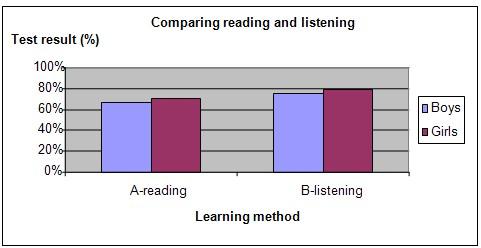| Complexity level: | 7 |
| Project cost ($): | 5 |
| Time required: | 1 day to prepare, 2 days for experiment |
| Material availability: | Easily found |
| Safety concerns: | None |
Hypothesis
Students who listen to the comprehension passage read to them will retain more information compared to students who read the comprehension passage themselves.
Overview
Learning by reading and listening
Learning in a classroom consists of both reading and listening. As the teacher scribbles away on the whiteboard or blackboard, we are rushing to read what is being written and copying it down in our exercise book. While writing, the teacher is also trying to explain the lesson to us. We usually have to listen, understand, read and write at the same time!
But which is the better method for learning, reading or listening? It may depend on the individual and the subject being taught.
Although people use both sides of their brain to comprehend and learn, most people have the tendency to use one side more than the other. This will actually determine how the person learns and which subject he will be better at.
It has been said that subjects that are fact or information-based like languages, history and geography are easier to learn through listening the taking down of notes. However subjects like science, mathematics and engineering that require analysis and understanding require more time to learn and are better studied by reading.
Scientific Terms
Materials
The materials required for this science fair project:
- 5 boys and 5 girls aged 15 years
- 2 sets of comprehension passages labeled A and B
- 2 sets of question papers for the above comprehension passages (labeled Paper A and Paper B)
- A quiet examination room
- An assistant to help coordinate the tests
Procedure
1. For this experiment, the independent variable is the reading and listening of comprehension passages. The dependent variable is the results of the tests. This is determined by marking and grading the test papers. The constants (control variables) are the difficulty of the tests, the number of questions, the time given to read the comprehension passage and the number of times the comprehension is heard.
2. 2 sets of comprehension passages of equal difficulty are selected and marked A and B. For each of the comprehension papers, a set of 50 objective questions are prepared and labeled paper A and paper B.
3. Model answers are prepared to mark and grade the papers after each test.
4. On the day of the test, the students are given the comprehension piece marked A to read for 30 minutes. After the 30 minutes, the comprehension passages are collected back and the test paper labeled A is given to the students to answer. After 1 hour the test papers are collected back.
5. On the next day of the test, the comprehension passage marked B is read out to the students several times during the given 30 minutes. The test papers labeled B are given out to the students to answer. After 1 hour the test papers are collected back.
6. All the 20 exam papers are marked and graded using the model answers and the results recorded in the table given below.

Results
The results show that the students’ performance in the tests is better after listening compared to reading. The boys and girls scored higher for the test B compared to test A.
Grouping |
Exam Paper A (%) |
Avg |
Exam paper B (%) |
Avg |
||||||||
1 |
2 |
3 |
4 |
5 |
1 |
2 |
3 |
4 |
5 |
|||
Boys |
56 |
64 |
78 |
72 |
62 |
66.4% |
72 |
68 |
86 |
76 |
74 |
75.2% |
Girls |
64 |
82 |
74 |
66 |
68 |
70.8% |
68 |
88 |
84 |
78 |
76 |
78.8% |
The graph below represents the results of our science project experiment.

Conclusion
The hypothesis that students who listen to the comprehension passage read to them will retain more information compared to students who read the comprehension themselves is proven to be true.
The use of audio as a teaching tool has been around for sometime. Language and motivational tapes or CDss are the most common. The advantage is thatI theyt can be listened to while doing other chores like driving, cooking or gardening. Listening to the tapes over and over again helps us to remember and retain better.
Also consider
The experiment can performed on subjects of a different age group.
Try to compare the results by repeating the experiment using visual teaching like power point presentations or pictures.
References
Audio versus visual learning - http://www.ehow.com/about_5263298_audio-versus-visual-learning.html
The importance of reading and listening - http://www.english.hb.pl/articles/input/

